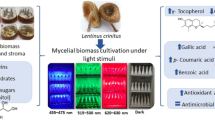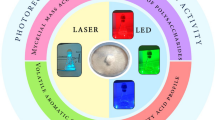Abstract
To investigate effects of light wavelengths and coherence on growth of liquid-cultured Inonotus obliquus mycelia, melanin accumulation and enzymes activity, culture condition as light of different wavelengths and coherence were studied. Short-term exposure of the vegetative mycelium by low-intensity coherent blue light was optimal for stimulation of growth, melanin synthesis, and increase in extracellular and intracellular activities of tyrosinase and polyphenoloxidase and extracellular catalase. Red coherent light, in the same mode, can effectively be used to stimulate the growth of mycelium and to increase intracellular and extracellular activity of polyphenoloxidase, extracellular catalase and tyrosinase, and intracellular peroxidase. Low-coherent light had less stimulating effect on the biosynthetic activity of I. оbliquus. It should be used in the cultivation directed at the obtaining endomelanin, polyphenoloxidase, and extracellular tyrosinase.





Similar content being viewed by others
References
Zheng, W. F., Gu, Q., Chen, C. F., Yang, S. Z., Wei, J. C., & Chu, C. C. (2007). Aminophenols and mold-water-extracts affect the accumulation of flavonoids and their antioxidant activity in cultured mycelia of Inonotus obliquus. Mycosystema, 26, 414–426.
Chen, C. F., Zheng, W., Gao, X., Xiang, X., Sun, D., Wei, J., & Chu, C. (2007). Aqueous extract of Inonotus obliquus (Fr.) Pilát (Hymenochaetaceae) significantly inhibits the growth of sarcoma 180 by inducing apoptosis. American Journal of Pharmacology and Toxicology, 2, 10–27.
Saar, M. (1991). Fungi in Khanty folk medicine. Journal of Ethnopharmacology, 31, 175–179.
Zheng, W., Miao, K., Liu, Y., Zhao, Y., Zhang, M., Pan, S., & Da, Y. (2010). Chemical diversity of biologically active metabolites in the sclerotia of Inonotus obliquus and submerged culture strategies for up-regulating their production. Applied Microbiology and Biotechnology, 87, 1237–1254. doi:10.1007/s00253-010-2682-4.
Xu, X., Wu, Y., & Chen, H. (2011). Comparative antioxidative characteristics of polysaccharide-enriched extracts from natural sclerotia and cultured mycelia in submerged fermentation of Inonotus obliquus. Food Chemistry, 127, 74–79.
Wang, Z. H., Huo, Y. F., Wang, B., & Shen, J. W. (2006). Submerged fermentation of Inonotus obliquus. Mycosystema, 25, 461–467.
Babitskaya, V. G., Scherba, V. V., Ikonnikova, N. V., Bisko, N. A., & Mitropolskaya, N. Y. (2002). Melanin complex from medicinal mushroom Inonotus obliquus (Pers.:Fr.) Pilat (Chaga) (Aphyllophoromycetideae). International Journal of Medicinal Mushroom, 4, 139–146.
Zheng, W. F., Zhang, M., Zhao, Y., Wang, Y., Miao, K., & Wei, Z. (2009). Melanin complex from medicinal mushroom Inonotus obliquus (Pers.:Fr.) Pilat (Chaga) (Aphyllophoromycetideae). Bioresource Technology, 100, 1327–1335.
Chen, Q.-X., Song, K. K., Qiu, L., Liu, X. D., Huang, H., & Guo, H. Y. (2005). Inhibitory effects on mushroom tyrosinase by p-alkoxybenzoic acids. Food Chemistry, 91, 269–274.
Sugimoto, K., Nomura, K., Nishimura, T., Kiso, T., Sugimoto, K., & Kuriki, T. (2005). Syntheses of α-arbutin-α-glycosides and their inhibitory effects on human tyrosinase. Journal of Bioscience and Bioengineering, 99, 272–276.
Solano, F., Briganti, S., Picardo, M., & Ghanem, G. (2006). Hypopigmenting agents: an updated review on biological, chemical and clinical aspects. Pigment Cell Research, 19, 550–571.
Zheng-Fei, Y., Yang, Y., Feng-Hua, T., Xin-Xin, M., Yu, L., & Chang-Tian, L. (2014). Inhibitory and acceleratory effects of inonotus obliquus on tyrosinase activity and melanin formation in B16 melanoma cells. Evidence-Based Complementary and Alternative Medicine, Article ID 259836, 11 pages. doi:10.1155/2014/259836.
Scandalios, J. G. (2005). Oxidative stress: molecular perception and transduction of signals triggering antioxidant gene defenses. Brazilian Journal of Medical and Biological Research, 38, 995–1014.
Gaetani, G. F., Ferraris, A. M., Rolfo, M., Mangerini, R., Arena, S., & Kirkman, H. N. (1996). Predominant role of catalase in the disposal of hydrogen peroxide within human erythrocytes. Blood, 87, 1595–1599.
Morita, Y., Yamashita, H., Mikami, B., Iwamoto, H., Aibara, S., Terada, M., & Minami, J. (1988). Purification, crystallization, and characterization of peroxidase from Coprinus cinereus. Journal of Biochemistry, 103, 693–699.
Isobe, K., Inoue, N., Takamatsu, Y., Kamada, K., & Wakao, N. (2006). Production of catalase by fungi growing at low pH and high temperature. Journal of Bioscience and Bioengineering, 101, 73–76.
Stajic, M., Persky, L., Friesem, D., Hadar, Y., Wasser, S. P., Nevo, E., & Vukojevic, J. (2006). Effect of different carbon and nitrogen sources on laccase and peroxidases production by selected Pleurotus species. Enzyme and Microbial Technology, 38, 65–73.
Thiyagarajan, A., Saravanakumar, K., & Kaviyarasan, V. (2008). Optimizaton of extracellular peroxidase production from Coprinus sp. Indian Journal of Science and Technology, 1, 1–5.
Fedotov, O. V., & Voloshko, T. E. (2013). Producing of enzyme preparation and analysis of enzyme preparation of peroxidase and catalase of some species of Basidiomycetes. Biological Bulletin of Bogdan Chmelnitskiy Melitopol State Pedagogical University, 1, 113–127. In Russian.
Corrochano, L. M. (2011). Fungal phototobiology: a synopsis. IMA Fungus, 2, 25–28.
Zheng, W., Zhang, M., Zhao, Y., Miao, K., & Jiang, H. (2009). NMR-based metabonomic analysis on effect of light on production of antioxidant phenolic compounds in submerged cultures of Inonotus obliquus. Bioresource Technology, 100, 4481–4487.
Poyedinok, N. L., Buchalo, A. S., Negriyko, A. M., Potemkina, J. V., & Mykchaylova, O. B. (2003). The action of argon and helium-neon laser radiation on growth and fructification of culinary-medicinal mushrooms Pleurotus ostereatus, Lentinus edodes and Hericium erinaceus. International Journal of Medicinal Mushroom, 5, 251–257.
Poyedinok, N. L., Mykchaylova, O. B., Shcherba, V. V., Buchalo, A. S., & Negriyko, A. M. (2008). Light regulation of growth and biosynthetic activity of Ling Zhi or Reishi medicinal mushroom, Ganoderma lucidum (W. Curt.: Fr.) P. Karst. (Aphyllophoromycetideae), in pure culture. International Journal of Medicinal Mushrooms, 10, 369–378. doi:10.1615/IntJMedMushr.v10.i4.100.
Sommer, T., Chambers, J. A., Eberle, J., Lauter, F. R., & Russo, V. E. (1989). Fast light-regulated genes of Neurospora crassa. Nucleic Acids Research, 17, 5713–5723.
Moor, D. (2002). Fungal morphogenesis. Cambridge University Press, 469 p. ISBN-10: 0521552958.
Chen, C. H., Ringelberg, C. S., Gross, R. H., Dunlap, J. C., & Loros, J. J. (2009). Genome-wide analysis of light-inducible responses reveals hierarchical light signalling in Neurospora. EMBO Journal, 28, 1029–1042.
Tisch, D., & Schmoll, M. (2010). Light regulation of metabolic pathways in fungi. Applied Microbiology and Biotechnology, 85, 1259–1277.
Ermakov, A.I., Arasimovich, V.V., Yarosh, N.P. et al. (1987). Methods of biochemical analyses of plant. (Ermakov, A.I., ed.), 3th ed., L.:Agropromizdat. (In Russian).
Korolyuk, M. A., Ivanova, L. I., Majorova, I. G., & Tokarev, V. E. (1988). Methods for determination of catalase activity. Laboratory Work, 1, 16–19 (In Russian).
Bradford, M. M. (1976). A rapid and sensitive method for the quantitation of microgram quantities of protein utilizing the principle of protein-dye binding. Analytical Biochemistry, 72, 248–254.
Karu, T.I. (2003). Lasers in medicine and dentistry. vol. 3. Z. Simunovic (Edn.) Vitgraf: Rieka. pp. 79–100.
Karu, T.I. (2011). Light coherence. Is this property important for photomedicine? Available from: http://www.photobiology.info/Coherence.html. Accessed 06 April, 2011.
Rubinov, A. N., & Afanas’ev, A. A. (2005). Nonresonance mechanisms of biological effects of coherent and incoherent light. Optics Spectroscopy, 98, 943–948.
Hode, L. (2005). The importance of the coherency. Photomedicine and Laser Surgery, 23, 431–434.
Zalevsky, Z., & Belkin, M. (2011). Coherence and speckle in photomedicine and photobiology. Photomedicine and Laser Surgery, 29, 655–656.
Tamalaitis, G., Duchovskis, P., Bliznikas, Z., Breive, K., Ulinskaite, R., Brazaityte, A., Novičkovas, A., & Žukauskas, A. (2005). High-power light emitting diode based facility for plant cultivation. Journal of Physics D: Applied Physics, 38, 3182–3187.
Laser technology in agriculture (2008). Moscow: technosphere. (In Russian)
Namba, K., lnatomi, S., Mori, K., Shimosaka., Okazaki, M. (2002). Effects of LED lights on fruiting-body production in Hypsizigus marmoreus. Mushroom Science Biotechnology, 10, 141–146.
Abe, M. (2007). Effect of the light emitting diode irradiation on mycelial growth and yield of Shiitake (Lentinula edodes). Mushroom Science Biotechnology, 15, 103–108 (in Japanese).
Miyazaki Y., Masuno K., Abe M., Nishizawa, H., Tetsuo Matsumoto, T., et al. (2011). Light-Stimulative Effects on the Cultivation of Edible Mushrooms by Using Blue Led. Proceedings of the 7th International Conference on Mushroom Biology and Mushroom Products (ICMBMP7), Arcachon, France, 4-7 October 2011, 58 – 67.
Wasser, S. P., Sokolov, D., Reshetnikov, S. V., & Timor-Tismenetsky, M. (2000). Dietary supplements from medicinal mushrooms: diversity of types and variety of regulations. International Journal of Medicinal Mushrooms, 2, l–19.
Karu, T. I., Kurchikov, A., Letokhov, V., & Mokh, V. (1996). He-Ne laser radiation influences single-channel ionic currents through cell membranes: a patch-clamp study. Lasers in the Life Sciences, 7, 35–48.
Lengeler, K. B., Davidson, R. C., D’Souza, C., Harashima, T., Shen, W. C., Wang, P., Pan, X., Waugh, M., & Heitman, J. (2000). Signal transduction cascades regulating fungal development and virulence. Microbiology and Molecular Biology Reviews, 64, 746–785.
Tisch, D., Kubicek, C. P., & Schmoll, M. (2011). New insights into the mechanism of light modulated signaling by heterotrimeric G-proteins: ENVOY acts on gna1 and gna3 and adjusts cAMP levels in Trichoderma reesei (Hypocrea jecorina). Fungal Genetics and Biology, 48, 631–640.
Tisch, D., & Schmoll, M. (2013). Targets of light signaling in Trichoderma reesei. BMC Genomics, 14, 657.
Author information
Authors and Affiliations
Corresponding author
Rights and permissions
About this article
Cite this article
Poyedinok, N., Mykhaylova, O., Tugay, T. et al. Effect of Light Wavelengths and Coherence on Growth, Enzymes Activity, and Melanin Accumulation of Liquid-Cultured Inonotus obliquus (Ach.:Pers.) Pilát. Appl Biochem Biotechnol 176, 333–343 (2015). https://doi.org/10.1007/s12010-015-1577-3
Received:
Accepted:
Published:
Issue Date:
DOI: https://doi.org/10.1007/s12010-015-1577-3




